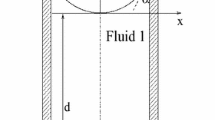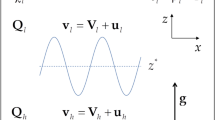Abstract
Shaping arbitrary fluid interfaces opens interesting perspectives for fluid-based processes and experiments. We demonstrate an experimental method to create non-planar static interfaces of almost arbitrary shape between two fluids, one of which is made highly magnetically permeable by the addition of a magnetic compound. By relying on spatially modulated magnetic fields, a non-homogeneous magnetic force is added to Earth's gravitational force, and a non-planar static interface can be stabilized. Precision experimental measurements are possible because we have developed a general method that allows us to predict numerically the shape of the interface, thereby facilitating the optimal experimental design before actually implementing it. As a first example, we apply this method to the Rayleigh–Taylor instability between two immiscible fluids. The results we obtain demonstrate the feasibility of the experimental method and the accuracy of the numerical predictions.










Similar content being viewed by others
References
Bystrova EN, Kalaev VV, Smirnova OV, Yakovlev EV, Makarov YuN (2003) Prediction of the melt/crystal interface geometry in liquid encapsulated Czochralski growth of InP bulk crystals. J Cryst Growth 250:189–1994
Carlès P, Huang Z, Carbone G, Rosenblatt C (2006) Rayleigh–Taylor instability for immiscible fluids of arbitrary viscosities: a magnetic levitation investigation and theoretical model. Phys Rev Lett 96:104501
Chen PY, Chang CL, Huang KY, Lan CW, Cheng WH, Huang SL (2009) Experiment and simulation on interface shapes of an yttrium aluminium garnet miniature molten zone using the laser-heated pedestal growth method for single-crystal fibers. J Appl Cryst 42:553–563
Ekeland I, Temam R (1976) Convex analysis and variational problems. North-Holland Publishing Company, Amsterdam, pp 34–35
Hecht F, Pironneau O, Le Hyaric A, Morice J, Freefem++ version 3.12-0 (2d and 3d), http://www.freefem.org/ff++/
Huang Z, De Luca A, Atherton TJ, Bird M, Rosenblatt C Carlès P (2007) Rayleigh–Taylor instability experiments with precise and arbitrary control of the initial interface shape. Phys Rev Lett 99:204502
Mahajan MP, Tsige M, Taylor PL, Rosenblatt C (1998) Stability of Magnetically levitated liquid bridges of arbitrary volume subjected to axial and lateral gravity. Phys Fluids 10:2208
Mahajan MP, Tsige M, Zhang S, Alexander JID, Taylor PL, Rosenblatt C (2002) Collapse dynamics of liquid bridges investigated by time-varying magnetic levitation. Exp Fluids 33:503–507
Nelder JA, Mead R (1965) A simplex method for function minimization. Comput J 7:308–313
Renoult MC, Atherton TJ, Rosenblatt C, Carlès P (2009) Creating non-planar static interfaces with magnetic fields. In: AIP conference proceedings 1207
Vizman D, Watanabe M, Friedrich J, Müller G (2007) Influence of different types of magnetic fields on the interface shape in a 200 mm Si-EMCZ configuration. J Cryst Growth 303:221–225
White J, Oakley J, Anderson M, Bonazza R (2010) Experimental measurements of the nonlinear Rayleigh–Taylor instability using a magnetorheological fluid. Phys Rev E 81:026303
Takeda M, Nishigaki K (1991) Shape deformation of the gaz-liquid interface of liquid oxygen in high-magnetic fields. Phys Rev A 43:2081–2083
Acknowledgments
We wish to thank Dr. Sameh Ferjani (Department of Physics, CWRU) for experimental assistance and Myriam Comte (Laboratoire Jacques-Louis Lions, UPMC-Paris6 / CNRS) for helpful suggestions. This work has been supported by the Partner University Fund, administered by the FACE Foundation and the French Embassy in Washington, D.C. C.R. thanks the Fulbright Foundation for support during his residency at UPMC.
Author information
Authors and Affiliations
Corresponding author
Appendix: Proof of uniqueness for the energy minimization problem
Appendix: Proof of uniqueness for the energy minimization problem
Theorem
We claim that (1) if a functional has a Lagrangian whose Hessian is positive definite, then it has a single absolute minimum and (2) provided that the equivalent gravity always points to the same half-plane, the energy of the equilibrium interface admits a unique minimum.
Proof 1
Note that this mathematical result is well known and can be found, for instance, in Ekeland and Temam (1976).
Suppose F a functional whose Lagrangian f is defined by
where η′ = dη/dy, and suppose we want to minimize F.
Let f be a regular function with a second derivative whose Hessian, defined by
is positive definite, e.g., for any non-zero vector ν
That f has a positive definite Hessian is equivalent to f being strictly convex (see Ekeland and Temam 1976). Suppose now that we find a minimum of functional F for η = η m , then we claim that this minimum is unique. Specifically, we can introduce the function G defined on the interval [0,1] by: \(G(\lambda)=F(\eta_{m}+\lambda\Updelta)\) with \(\Updelta=\eta-\eta_{m}\). Note that G(0) = F(η m ) and G(1) = F(η). And let us define
where \(\Updelta^{\prime}= \hbox{d}\Updelta/\hbox{d}y\) and \(\eta^{\prime}_{m}=\hbox{d} \eta_{m}/ \hbox{d}y\).
The inequality above follows from the fact that D is positive definite (this can be found by letting \(\nu=(\begin{array}{c} \Updelta \\ \Updelta^{\prime}\\ \end{array})\)).
Now let us first see whether we can find η so that F(η) < F(η m ).
We can write that
This follows from the definition of the integral, first applied to \(G(\lambda)=F(\eta_{m}+\lambda\Updelta)\) and then to its derivative dG/dλ. Implementing this, we find that
By assumption η m is an extremum. Thus, the second term (first integral) on the right-hand side is zero (note that the domain of definition of f is not bounded). Now, the last term, as an integral of a strictly non-negative quantity, is strictly non-negative. It follows that there is no η such that F(η) < F(η m ).
Let us now examine whether we can find η ≠ η m such that F(η) = F(η m ). Suppose that such an η exists. Since f is, by assumption, a regular and strictly convex function, the integral of f on a bounded domain (such as F) is strictly convex too. By using the strict convexity of F on the interval [η m , η], we can write that for all \(t\in ]0,1[\),
Taking \(t=\frac{1}{2}\) (for example), we find that
which means that for η m , the value of F is larger than for \(\frac{\eta + \eta_{m}}{2},\) which is not possible according to the previous result. Thus, there is no η ≠ η m such that F(η) = F(η m ).
Consequently, we can claim that η m is the single absolute minimum of F. \(\square\)
Proof 2
For our particular case, the Lagrangian of our energy functional E is given by:
Calculating the determinant of its Hessian leads to:
Since we have constrained the equivalent gravity always to point to the same half-plane, we have
which means that D in our case is positive definite. Thus, the solution to our energy minimization problem is unique under the chosen set of assumptions.\(\square\)
Rights and permissions
About this article
Cite this article
Renoult, MC., Petschek, R.G., Rosenblatt, C. et al. Deforming static fluid interfaces with magnetic fields: application to the Rayleigh–Taylor instability. Exp Fluids 51, 1073–1083 (2011). https://doi.org/10.1007/s00348-011-1125-z
Received:
Revised:
Accepted:
Published:
Issue Date:
DOI: https://doi.org/10.1007/s00348-011-1125-z




